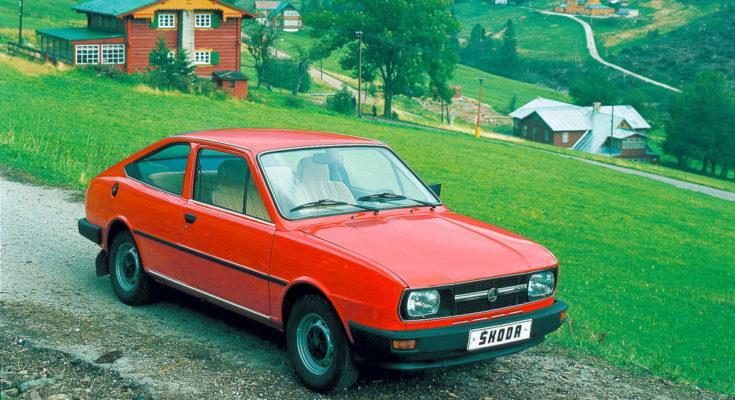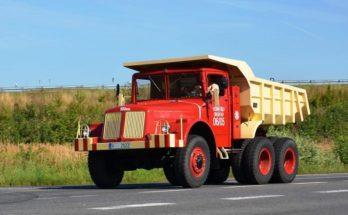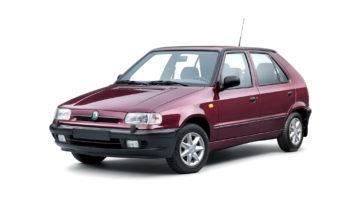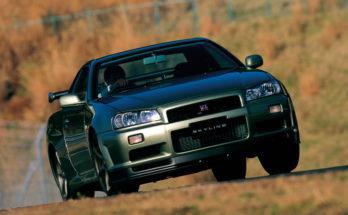Since 1968 , sports cars were not a common phenomenon in the Czech Republic. The only exception was the Skoda 110 R Coupé and then its successors – the Skoda Garde and, after modernization, the Rapid .
Both models are derived from the sedan series 105/130 with the designation 742. The coupe then bore the designation 743 or 747 in the case of more powerful versions of the Rapid. Garde was first introduced to the public in 1981 at the engineering fair in Brno, as the successor to the very popular Skoda 110 R Coupé. With the modernization of the original 742 series, the same elements were introduced to both baths and the Garde was renamed Rapid . In addition to the same base, both models are united by a frameless two-door self-supporting body. Production took place at plants in Kvasiny and Bratislava (here, by the way, it became the first mass-produced car). A total of 44,634 units of all Garde/Rapid versions were assembled in these plants until 1990.
The first to arrive in 1981 was the Garde coupe. The design is based on the 742 sedan from 1980. Under the hood appeared a single 1174 cm³ engine with a power of 55 hp at 5200 rpm and a torque of 85.5 Nm at 3250 rpm from the 120 LS model. Together with the engine, the entire car was set in motion by a four-speed manual transmission , which transmitted power to the rear wheels. The coupe is 4175 mm long, 1610 mm wide and 1400 mm high. Even with a curb weight of just 915kg and a wheelbase of 2400mm, the Garde is quite nimble. The coupé reaches 100 km/h in 18 seconds and reaches a maximum speed of 153 km/h.
The Garde chassis consisted of a front trapezoidal axle (gauge 1320 mm) with a pair of swinging arms and a rear angular pendulum axle (gauge 1290 mm) with trailing arms. An interesting convenience was the rack-and-pinion steering system fitted as standard at the time, stopping was handled by disc brakes with four pistons at the front and drum brakes at the rear. The price of a new car in 1983 was 83,500 CZK . A total of 8,248 Garde units were produced, including the Rapid 120, but 11,179 cars were produced. Many of the units produced were exported and, apart from the Garde name, were sold as Skoda Rapid and Skoda 120 R.
In 1984, a significantly modernized Garde appeared with the designation Rapid , which was visually and technically based on the changes made in 1983 to the 105/120 series. The Rapid thus received a new front part , a 70 mm larger front wheel track and a 60 mm larger rear wheel track, an increased diameter of the clutch, a five-speed gearbox and new engine variants for the more powerful versions. Thanks to the modified front part, the length increased to exactly 4200 mm, while the height, on the other hand, decreased to 1380 mm.
Although new engine variants appeared in the offer, until 1986 Skoda continued to offer the Rapid with the basic 1200 from the sedan 120 LS with a power of 55 hp and a torque of 85.5 Nm. This model is sometimes referred to as the Rapid 120 . In addition to the engine, the complete technology including axles, brakes, four-speed gearbox and rear axle drive was taken over from Garde. A total of 2,931 Rapids were produced with the basic 1200.
On the market, a more powerful variant of the Rapid 130 , which differed from the Rapid 120 mainly by the engine from the Skoda 130 with a volume of 1289 cm³ . The maximum output of 58 hp at 5000 rpm and a torque of 97 Nm at 2800 rpm is transmitted to the rear wheels by a five-speed manual transmission . With a curb weight of 890 kg, the Rapid 130 sprints to 100 km/h in 16 seconds, but the top speed of 153 km/h is unchanged from the Rapid 120. Production of the model ended in 1988 with a total of 22,475 vehicles. An interesting fact is that based on the Rapid 130, a Sport version was also created in England , which was an official modification carried out by the importer himself. The power of the engine, which received a Weber carburettor, a sports camshaft, a new head, an electric fuel pump, a K&N air cleaner, a modified exhaust pipe and higher compressions, rose to 75 hp at 6000 rpm and torque to 105 Nm at 3500 rpm. / min. Rapid accelerated to 100 km/h in 13 seconds and went up to 165 km/h! Better driving characteristics of the car were ensured by new springs and shock absorbers, which at the same time reduced the ground clearance. Visually, the Sport version was recognizable by the plastic body accessories.
In 1987, the Favorit appeared, as well as a modernized version of the Rapid with the designation 135 (type 747). The main novelty of the 135 was the installation of an all-aluminum four-cylinder with a volume of 1289 cm 3 with a number of parts originally from Favorit in combination with a five-speed manual transmission. Power was still the same 58 hp at 5000 rpm, torque even dropped to 94 Nm at 3250 rpm, but the sprint to 100 km/h was fundamentally improved, where the Rapid 135 found itself in 15 seconds. Export versions received Bendix injection and were designated Rapid 135 Ri . Later, the letter C was added, which indicated the catalyst and the power reduced to 56 hp. Production ended in 1990 and 1,272 were produced.
The last and most powerful Rapid was the Rapid 136 version, which was also produced from 1987. The engine was structurally derived from the one in the Favorit 136, but lacked the Pierburg carburettor , which was replaced by a Czech Jikov carburettor. Compared to the Rapid 135, the output rose to 62 hp at 5,000 rpm and the torque to 100 Nm at 3,000 rpm. The maximum speed was still the same 150 km/h, but the Rapid 136 reached 100 km/h in just 14 seconds and that made it the fastest model in the entire model range ! The transmission was still a five-speed manual. The export versions, like the Rapid 135, received Bendix injection and were called the Rapid 136 Ri. Later, the letter C was also added, indicating the catalyst. By 1990, 9,708 units of the Rapid 136 were produced.
It was not unusual in the world of that time to produce a convertible in addition to a coupe, but Skoda did not officially offer a convertible derived from the Garde or Rapid, which opened up space for various amateur and professional modifications. The Austrian company Graf & Stift , which built its model on the basis of the Skoda Garde, is responsible for the very first conversion to a convertible. The car has a canvas roof and the entire model was created simply by removing the metal roof, which was replaced by a textile cover. A total of 10 cars were modified in this way. The second Garde Cabrio was produced by Meise , whose model features frameless side window construction and the same folding roof style as the Graf & Stift version. Models from Meis were produced in the number of 28 pieces.
Another modification already has its basis in the Skoda Rapid 136, which was rebuilt by the German company Hainzinger , which found a production partner in the Czech company Metalex (MTX) . The model was produced in the Czech Republic from some imported parts from Germany. Metalex produced 12 cars, Hainzinger in Germany another 6. Not one of them ended up here as new.
Perhaps the most well-known modification to the cabriolet is due, somewhat paradoxically, to the British. Ludgate Design & Development (LDD) produced the largest series of Rapid (Garde) Cabrios . The modifications were divided into two levels – standard and Lux. You can easily recognize the standard – it has a massive arch and lacks rear side windows. The Lux Veze differs from the standard mainly in the concept of a retractable roof, as it retained the rear side windows. A similar solution is known, for example, from today's Fiat 500C. There is even a Lux Sport version, which has more power and plastic body accessories. However, only 2 pieces were produced. The Rapid 136 was mostly used as the basis, but you can also find the Rapid 130. A total of 343 Garde/Rapid LDD convertibles were produced. However, it is not known how many from each version.
In addition to the above-mentioned modifications, there are also versions specially adapted in Canada (rebuilt at the local Skoda dealer in Toronto with the number of six units produced), in Denmark (9 units rebuilt) or in Holland (no detailed information, construction perhaps similar to Garde Graf & Stift).
In addition to the open versions, there are several interesting turns in the history of both cars. The first is a prototype with the name Locusta, which was created at the Bratislava Automobile Works (BAZ). In 1981, engineers at BAZ began converting the Garde, i.e. a rear-engine hatchback, into a front-engine coupe with front-wheel drive . The body of the Garde model has been completely redesigned, with the front axle moved forward by 70 mm and the rear flowing part, which can be completely folded out. The front part received four circular lights located under a plastic cover, two at a time. And what is actually the purpose of moving the axle? The Locust was fitted with an engine from Zastava 101 – i.e. a four-cylinder OHC 1.1 liter with an output of 55 hp. The engine was mounted transversely at the front and the front axle was driven, creating space for luggage in the rear. In BAZ, serial production was expected from 1985 and with the number of up to 50,000 manufactured pieces by 1990. This did not happen, and Garde and later Rapids began to be assembled in BAZ…
The second no less interesting chapter in the history of the Garde/Rapid models is the rally derivative , which was not created directly under the Skoda banner. It's surprising, because in 1983 the Mladá Boleslav carmaker came up with the underpowered and outdated 120 L of Group A as a successor to the legendary 130 RS . Of course, there were ideas for a much more powerful machine, but they were swept off the table almost immediately. The solution came from Metalex , which installed a 160-horsepower Lady six-cylinder gasoline engine in the Garde coupe, which was increased to 170 horsepower in 1984. This solution was not supported by the management of the car company, so the 160 RS was "taken under its wing" by the Jednotné zemědělské družstvo Slušovice , which ordered three pieces of the 160 RS from Metalex (thanks to this, the car got the nickname Bastard). Two of them were equipped with a Lada engine, one with a unit from a 130 RS, and the plans were really ambitious – to participate in the official World Rally Championship, where Group B machines were running rampant at the time.
Compared to the series, the coupe was overall lighter (weight 1000 kg) and received a body with laminate parts (it is about 10 cm longer compared to the series) with extended fenders, without bumpers, with a modified trunk lid and engine hood. In the interior, a racing cage found its place, MTX anatomical seats with Moravan four-point belts and an MTX sports steering wheel. The chassis consisted of a front trapezoidal axle with rack and pinion steering and an MTX rear axle with a new suspension. All brakes were disc mounted behind MTX aluminum wheels with 185/60-13 tires. The four-speed transmission had its origins in the Skoda 130 RS, the five-speed for a change came directly from MTX. In addition to the engines from the Lady and 130 RS, it was planned to use a more powerful engine with a volume of 1800 cm 3 and a power of up to 175 hp.
However, in order for Agroteam to participate in the championship, it was necessary to produce a homologation series of 200 pieces, which of course they did not give permission in Boleslav. By that time, however, Garde models were also being created in Bratislava, where they agreed to produce the homologation series. However, the relations between the Slušovice JZD and Skoda were very strained (also because the 120 L factory racing models were nowhere near as successful and ambitious as the non-factory ones), and the management of the car company decided that Garde production at BAZ would end. This also ended Garde's vision in Group B. The 160 RS went to a total of three races – the Valašská zima (Václav Blahna led with a huge lead here, but due to his own mistake did not finish), the Šumava rally (2nd place) and the Teplice rally (did not finish).
And finally, one more Garde in racing modification , but this time from Slovakia. In 1981, the Skoda 130 RS with a turbocharged KKK K-26 turbocharged engine was introduced at the Baba Hill race, which was created by Ing. Jozef Hrivnák and Ing. Michal Didarbora. And since Bratislava Automobile Race was the guarantor of the race, a decision was made in 1983 to build its own special car in the A5 category with a new turbocharged engine. Skoda Garde produced in Bratislava was chosen as the basis for the conversion. Engineers developed a completely new special in 3.5 months, the heart of which was, of course, a new supercharged power unit. In addition to a turbocharger with a compression ratio reduced to seven, it also had a horizontal Weber carburetor . Total power rose to 174 hp at 7,000 rpm and torque to 178 Nm at 7,000 rpm. The thoroughly lightened Skoda Garde (total weight 720 kg), which received the name Salamander , was able to accelerate to 100 km/h in 5.1 seconds and reach up to 220 km/h on a straight. The engine was mounted between the axles in the Salamander, which required it to be rotated 180 degrees and placed in front of the four-speed gearbox. The body (length 4150 mm, wheelbase 2275 mm) was significantly influenced by aerodynamics, so that while the hood and fenders were made of polyester laminate, the sills, doors and rear end were made of duralumin sheet. The reinforcement was provided by the safety frame in the interior. The chassis was also modified – although the front axle originated in the serial model, it was modified, extended by 180 mm and placed 80 mm higher, the rear axle arms came from the Skoda 130 RS. Of course, there were sports springs and shock absorbers , which lowered the ground clearance of the car. The Salamander's racing career began in 1983 and ended less than a year later in 1984. In training runs, the vehicle flew off the track and was completely destroyed. The new model was no longer built due to a change in the regulations of the A5 class.
Source: wikipedia.org, author's archive, gardeweb.cz, Skoda Auto, google.com, foltyn.cz, auta5p.eu, skodamedia.cz, SKODA AUTO company archive




